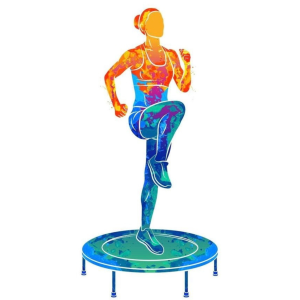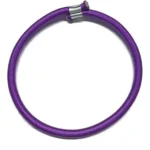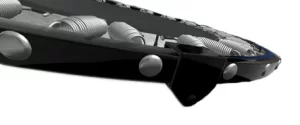15 Key benefits of rebounding and what to consider when buying a rebounder
What is rebounding?
Rebounding is an aerobic activity that involves bouncing on a mini-trampoline (rebounder).
Bouncing can be quick or slow, you determine your own intensity.
It is a fun way to stay fit, and there are numerous activities one can do on a rebounder. It also compliments other high-intensity exercises used in interval training.
Rebounding, among other things, can help work the muscles in your legs, increase endurance and strengthen your bones. This type of exercise is gaining popularity because it is easy on the joints while still working the cardiovascular system.
Because a rebounder provides so many benefits in just a short time, it is easy to fit into even the busiest person’s schedule.
Rebounding is one of the best ways to exercise and keep people fit as they age. It actively reverses the signs of aging in addition to being a low-impact routine that can be completed in short intervals at your own pace.

One of the best aspects of rebounding is that it is suitable for people of all ages. Anyone, from children to the elderly, can do it. Because it is low-impact, it is gentle on both growing bones and older bones and joints.
The following is a list of the 15 key health benefits of rebounding
Balance & Coordination
Rebounding improves balance, coordination, and overall motor skills.
When you bounce up and down, you are engaging both your ocular and inner ear canals which is in charge of things like balance.
Improving your coordination can help maintain your balance.
Brain Function
Rebounding can improve memory, creative thinking, and concentration while also slowing cognitive decline.
All exercise is beneficial to mental health, but this is one of the best.
When you combine physical and mental exercise, you can maintain your memory and cognitive function.
Cardiovascular Health
Rebounding is an excellent way to strengthen the heart, lower the risk of hypertension and clear the arteries of blockage caused by cholesterol buildup.
The gentle nature of rebounding allows us to do a lot more of it without experiencing negative consequences.
It encourages gentle, low-impact circulation, which aids in the rehabilitation of existing heart problems and recovery from heart procedures.
Digestive Health
Rebounding is a cardiovascular exercise that increases blood flow throughout the body. This benefit is most noticeable in the gastrointestinal tract.
Better circulation ensures that the muscles that keep your digestive system moving receive the oxygen and nutrients they require to function properly.
Rebounding can help you stay regular and get rid of waste in your body.
Endocrine Health
Rebounding enhances the endocrine system by removing excess hormones and toxins. It is an excellent method for rebalancing hormones.
It benefits and protects the endocrine system, which includes all of the glands in the body that produce and release hormones.
Hormones play an important role in regulating many different bodily functions. The thyroid gland, which is located in the neck is one of the most important glands.
Immune Health
You may experience fewer colds if you begin rebounding on a regular basis.
It can also help you clear your nose and to breathe better.
Many things in the body are controlled by the immune system.
This system is critical to your health, whether it is to detect and fight infections or by assisting in overcoming a common cold.
Lymph System
Rebounding improves lymphatic drainage, detoxifies the entire body, and stimulates immune function.
Rebounding increases your body’s lymphatic flow, which reduces cellulite in just a few months.
As the lymph fluid collects waste products, bacteria, and damaged cells, it also collects and drains damaged cancerous cells if they are present in the body via the lymphatic vessels.
Muscle Growth & Strength
Rebounding strengthens joints, tendons, and ligaments while toning and firming the entire body, increasing lean muscle mass.
It slows muscle atrophy, an inevitable result of the aging process.
It gives your body an increased G-force (or gravitational load). This improves your health and strengthens your musculoskeletal system.
Nervous System
Rebounding stabilises the nervous system, increasing resistance to environmental, physical, emotional, and mental stress.
A variety of sports injuries can result in nerve injury. The most common way to resolve this issue is to strengthen the muscles around the injured nerves.
Oxygen
Rebounding improves the production of red blood cells in the bone marrow.
Red blood cells transport oxygen and nutrients to tissues and aid in the removal of carbon dioxide.
Rebounding aids in the circulation of oxygen to the tissues.
Spring of Youth
Rebounding is one of the best exercises for keeping people fit as they age. It actively reverses the signs of aging in addition to being a low-impact routine that can be completed in short intervals at your preferred pace. The detoxification provided by increased lymph flow is beneficial to the skin and overall appearance.
Ten to fifteen minutes of rebounding per day can increase collagen production in the body. Collagen is well-known for its ability to provide skin strength and elasticity. It is also essential for healthy bones and cartilage.
Stress Relief
Rebounding increases the production of feel-good chemicals in the brain while decreasing stress hormones and allowing you to relax and sleep well after working out.
It reverses the effects of chronic stress. Rebounding can boost levels of calming brain chemicals like serotonin, dopamine, and norepinephrine.
It may also work at the cellular level to help reverse the effects of stress on the aging process.
Varicose Veins
According to research, rebounding improves muscle tone and blood flow in the legs, which aids in the treatment of varicose veins symptoms.
When combined with the fact that rebounding has no negative impact on the joints, this is without a doubt one of the best non-surgical ways to reduce the appearance of varicose veins and prevent future bouts from occurring.
Weight Loss
One of the primary reasons rebounding is so effective for weight loss is that it provides a cardio workout as well as building muscle.
Stronger muscles burn calories when you exercise and continue to do so when you rest.
Because rebounding is a fun way to exercise, it is easier to maintain, which is essential in any weight loss program.
A Word of Caution
If you are over the age of 50 and have any pre-existing medical conditions, such as back, or joint problems, poor circulation, or a history of heart problems I recommend that you speak to a qualified medical professional first before using a rebounder.
What to consider when buying a rebounder
Because not all rebounders are created equal, you should not simply buy any rebounder. Always make a well-informed decision.
Springs vs Bungee Cords
Springs are the first objects on the rebounder to be evaluated if you are interested in buying a spring rebounder. Here are the key factors to consider:
- Spring Quality and Type: It is best to avoid any rebounder that uses tube springs. That is still old school and for safety reasons not recommended. Rather, look for a rebounder with tapered steel springs. They can support a broader range of body weight and movement, making them more user-friendly and long-lasting.
- Spring Cover: Another thing to consider is the spring cover, it will keep you as well as the people around you protected during your routine in case anything unexpected might happen.
Advantages:
- Durability: Springs are typically very durable and can last a long time with proper maintenance.
- Cost: Spring rebounders are often more affordable than bungee models.
Disadvantages:
- Harsher Bounce: Springs tend to provide a firmer, sometimes harsher bounce compared to bungees, which may be less comfortable and more jarring.
- Noise: Springs can be noisy, which might be disruptive in quiet environments or shared spaces.
- Impact: The bounce can be harder on the joints compared to bungee rebounders.

Bungee Cords: When buying a bungee rebounder it is important to consider the following about the bungee cords:
- Material and Quality: Ensure the bungee cords are made from high-quality, durable materials like latex or synthetic rubber. Higher quality cords offer better elasticity and longevity.
- Thickness and Strength: Check the thickness and strength of the cords. Thicker cords generally provide more resistance and support, impacting the bounce quality and overall stability.
- Adjustability: Some rebounders have adjustable cords, allowing your to customise the bounce intensity. If this feature is important to you, make sure it is available.
- Attachment Points: Look at how the bungee cords are attached to the frame and mat. Secure and well-designed attachment points are crucial for safety and performance.
- Find out if replacement bungee cords are available and easy to obtain. Also, inquire about maintenance tips to prolong the life of the cords.
Advantages:
- Smoother Bounce: Bungee cords generally provide a smoother, quieter bounce compared to springs. This can be easier on the joints and more comfortable for extended use.
- Lower Impact: The elasticity of bungees absorbs impact better, making it gentler on the knees, hips, and back.
- Less Noise: Bungee rebounders are quieter, which is beneficial if you prefer a quieter exercise environment or live in an apartment.
Disadvantages:
- Durability: Bungee cords may wear out over time and may need replacement. Quality varies between brands.
- Cost: Bungee rebounders can be more expensive due to the cost of materials and construction.

Ultimately, both types of rebounders can provide an excellent workout, so your choice will depend on personal preferences regarding bounce feel, noise level, and budget.
The durability of the mat
For safety and reliability, the mat’s quality is equally as significant as the quality of the springs. Give special attention to the type of material used. Make sure the material can withstand stretching.
Look for a mat that will give enough support when exercising barefoot, allowing you to fully utilise a variety of workout routines.

Handlebar
Many rebounders include a built-in handlebar that can be used to keep yourself steady while bouncing. If you are a first-time rebounder, you may need it until your balance has improved to the point where you can bounce without it with confidence. The goal is not to rely on the handlebar.
Weight supported
Rebounding depends on bouncing and gravity to provide the necessary benefits. Based on your weight, one rebounder may provide better results than another. To get the most out of your bounce, the springs should be sufficiently tensioned, and all parts should fully support your weight for safety. When looking for a high-quality mat that won’t stretch over time, keep your own weight in mind.
Size and portability
Today’s rebounders come in a variety of sizes. They are pieces of exercise equipment that are simple to store and transport. If you intend to travel with your rebounder, look for a lightweight rebounder that comes with a carry case and can fold up to make storage and transportation easier.

Replacement parts
Regardless of how high the quality of an item is, something could cause it to break. As a result, choosing a rebounder with replaceable parts is essential. If something goes wrong you don’t want to be forced to buy an entirely new product
Structure and assembling
The rebounder’s base holds the entire unit together and provides structural support. Poor quality can increase the likelihood of the rebounder breaking and causing an accident. Steel units are far superior to those that incorporate plastic into the design. However, not all steel units are created equal. Consider how the rebounder is going to be assembled. Avoid units with screwed-in legs because they can wear out over time, become loose in storage, and offer less steady support. Legs that snap into place are far superior.

Frequently Asked Questions
How often should I replace the bungees or springs?
Bungees or springs should be replaced when they show signs of wear or lose their elasticity. Follow the manufacturer’s recommendations for replacement intervals.
Can I use a rebounder outdoors?
Most rebounders are designed for indoor use. Outdoor use can expose them to elements that may damage the materials, so check the manufacturer’s guidelines.
Do rebounders come with a safety handle?
Some models include a safety handle or bar to help with balance, especially useful for beginners or those needing extra support.
How do I clean and maintain a rebounder?
Regularly check for wear and tear, clean the mat with a damp cloth, and ensure the bungees or springs are in good condition. Follow the manufacturer’s maintenance recommendations.
How often should I do rebounding exercises?
Rebounding is a daily wake-up call for the body. The up-and-down movement increases circulation, massages internal organs, and can improve blood chemistry. Rebounding does not tear down or damage the body like many traditional exercise programs, so it is safe to do on a daily basis and multiple times a day.
How long should my rebounding routine be?
That is entirely up to you. It is recommended that you take it easy at first. You can begin with a few minutes of exercise per day and work your way up to longer sessions. If you have a serious medical condition, please consult your healthcare provider before starting with rebounding.
